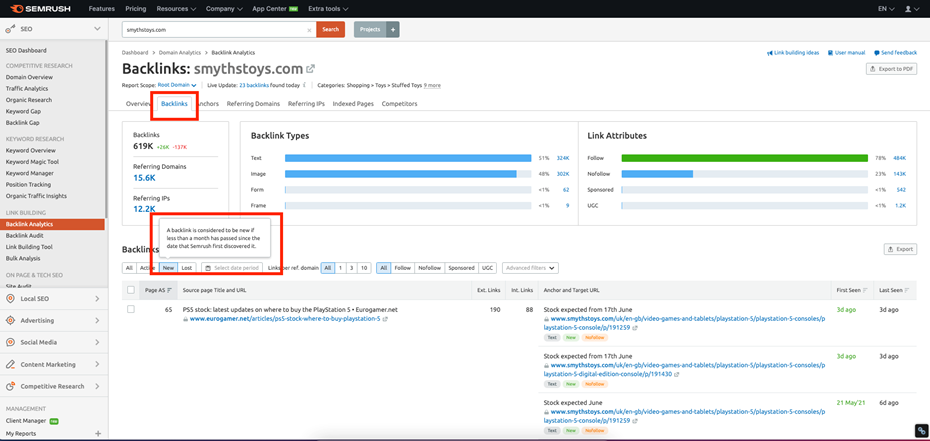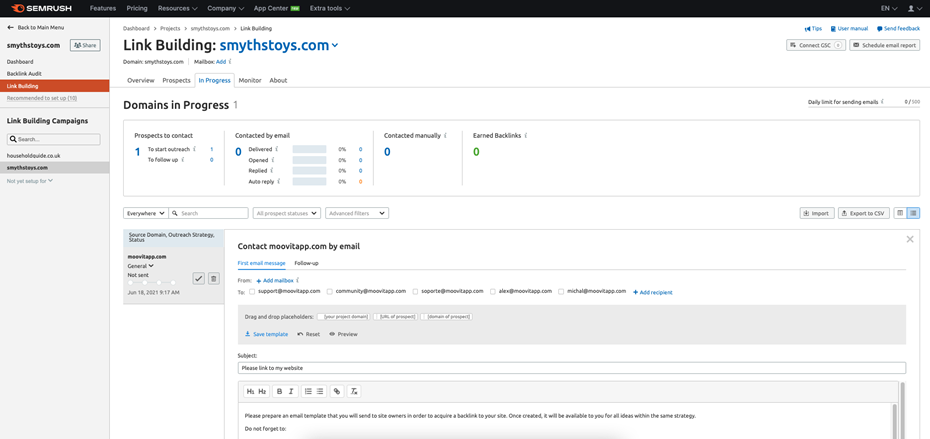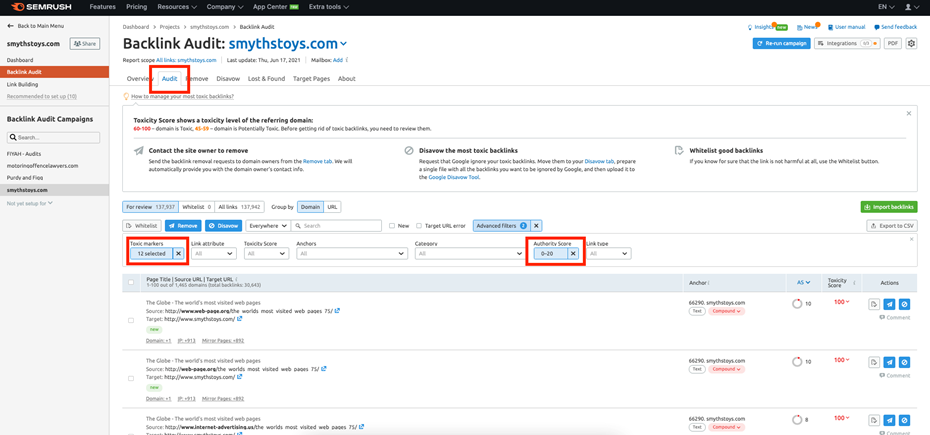Backlink profile management is one of the most important tasks an SEO professional can undertake.
However, so much goes into managing backlinks successfully, it can be daunting without help.
This year, Semrush dramatically improved the solutions we offer so that anyone can conduct dynamic backlink management with ease and right now our backlinks analytics is Free to everyone.
We recently asked our friends at Marketing Signals to take a test run of the new and improved backlink database.
Below is what Gareth Hoyle, CEO of Marketing Signals, had to say.
What Is Dynamic Backlink Management?
By leveraging the functionality of the suite of backlink tools in Semrush I’ll demonstrate how you can streamline several tasks into one seamless process known as dynamic backlink management.
This concept is characteristic of the Semrush link building suite.
With Semrush, you get a full set of tools that enable you to streamline a complete backlink workflow while getting the fastest data from their advanced backlink database and cutting-edge architecture.
In essence, everything that has made Semrush the leading tool for online marketers (speed, ease of use, powerful functionality, constant innovation, an intuitive UX) can be leveraged to help create your backlink management workflow – saving you valuable time while delivering tangible results.

Semrush Tools to Help Streamline Your Backlink Management
Let’s look at four tools:
- Backlink Analytics
- Backlink Audit
- Backlink Gap
- Link Building Tool
Read on to learn how you can execute critical link management tasks with these tools.
The domain I’ll be using for the demonstration is smythstoys.com, one of the leading online toy retailers in the UK. This is large site has more than 600,000 backlinks and more than 15,000 referring domains, with a healthy global estimated traffic volume of 16.4 million monthly visits.
Backlink Analytics
Your first port of call when starting link management activity should be the Backlink Analytics tool. It gives a nice top-level overview with insights into how authoritative a site is.
Below you can see the overview screen itself showing the different data and metrics available.
One thing that’s awesome about Semrush is the graphical nature of each dashboard, so much data is easily accessible on one screen. For example, you can see:
- Authority Score
- Referring domain count
- Backlink count
- Estimated monthly visits
- Top anchors texts
- Follow vs. Nofollow ratio
- Top pages
- Anchor text wordle
- Referring domains by Authority Score
This means you can quickly evaluate how authoritative a site is in a matter of seconds, as well as identifying areas that need attention.
The dashboard is so simple to navigate and the different charts provide lightning fast (but in-depth insights) into the nature of each domain you need to research.
For example, at a glance you can see there has been a steady flow of referring domains over the past year that has tailed off slightly in the last month. You can then formulate an actionable task based on this information (e.g., increase the link building velocity).

How to Find Fresh Links
One of the most common tasks anyone doing day-to-day backlink management will want to find is newly discovered links.
Backlinks analytics makes this super easy. Just click the second tab from the overview screen marked Backlinks and then filter by New.

If you really want the data at your fingertips, there is also a handy hyperlink to the newly discovered links for each day from the overview screen. Handy or what?

This is useful in so many ways.
If you are running a digital PR activity or just want to find out which high-traffic publications have linked to you recently, you can use the tool to look for new incoming links, such as this one from The Sun last month.
The data also updates really quickly. For example, another link from the same publication here has a publication date of June 10, 2021.

According to the Semrush tool data the link was First Seen five days previous to the time of writing, which would be June 12, 2021, so two days after it was first published.

In fact, according to a test run in Q1/Q2 of this year, the Semrush link database outperforms the competition when it comes to which tools discovered the first new backlinks the fastest.
In the example below, you can see how Semrush is capable of seeing links at 9:40 a.m. to a piece of content that only went live at 9 a.m. the same morning.

Benchmarking Against Competitors
Who Are Your Competitors?
Knowing how far behind or ahead you are of the competition is a vital insight that should inform your overall link building strategy.
Backlink Analytics allows you to conduct a really quick competitor analysis within the overview screen.
The best part? You don’t even have to declare who the competitors are. Semrush does the hard work for you by finding similar sites within the same niche.
Once completed, Semrush gives you useful authority metrics (e.g., the number of referring domains, backlinks, IPs, monthly visits, ranking keywords).
One fantastic feature is that once you have selected the sites you want to compare to, all the charts update with the competitor metrics data giving you an invaluable graphic illustration of your site versus the competition.
You can then start to draw insights – for example, the competitor with the highest traffic score is also likely to have the highest number of referring domains and the highest authority score.
In addition, the illustrative way in which the data is displayed lets you look at trends, such as increases or decreases in competitor link building activity.

Which Sites Link to Your Competitors But Not You
Here’s another really useful feature.
Once you have run a competitor analysis in overview mode you can scroll down to the Top Link building opportunities widget where you’ll be able to navigate directly over to Backlink Gap and find a host of potential outreach targets.
You’ll see that a bunch of sites are linking only to smythstoys.com competitors. You can then filter these (by Authority Score, monthly visits, etc.) to find the best outreach opportunities.
This process is another demonstration of how the Semrush link building tools suite lets you execute your link management workflow by finding relevant competitors and then providing you with a list of sites that link to your competitor (but not you).

How to Email Prospects Directly from Within Semrush
Once you find a list of prospects from Backlink Gap, you like the look of you can email them directly from within Semrush, so no need to open your inbox in a new window.
Simply select the link prospects in Backlink Gap and then hit the Start outreach button then click send prospects and these will then land in your Link Building Tool project. Connect your email (if not already done so) and you’re away!
So in three simple steps, Semrush has identified competitors, presented us with a list of outreach targets, and offered us the facility to email them within a matter of minutes.
This will save you valuable time versus doing these three steps separately, perhaps using multiple tools or software.

Backlink Maintenance
In many ways, maintaining your backlink profile is a bit like maintaining your car. If you don’t bother with the maintenance, eventually you’ll start to notice a drop in performance.
Typical backlink maintenance tasks include ensuring your links stay active as well as finding and then disavowing any unwanted/toxic links. For small sites, this is less of an issue (although still something worth keeping on top of). However, for larger sites with thousands of backlinks, it’s essential.
Once again, Semrush is your friend, both in terms of functionality but also in terms of sequencing. You can find and measure the toxic links and create a disavow file without leaving the software.
How to Set Up a Link Audit in Semrush
Simply head over to Backlink Analytics again and input the domain. Then click Set up Backlink Audit.
Semrush will start gathering the data (may take a couple of minutes depending on the size of the profile)

Once you have done that Semrush will take you to the Backlink Audit dashboard. Interestingly, despite smythstoys.com having a global organic traffic score of over 16 million, its link profile’s overall toxicity score is classified as High.
Semrush gives you a breakdown of the percentage of links it has classed as toxic, potentially toxic, and non-toxic.

How to Find Broken, Lost & Toxic Links
Staying within the Backlink Audit screen, simply click on the Audit tab and then use the filters.
The best thing about this? Semrush gives you a ton of different metrics to refine the data.
This includes an extensive list of their top-level cohorts (e.g., “Harmful environment”, “Spam in communities”, “Manipulative links”, “Complementary”) all of which have subcategories (e.g., “non-indexed”, “Spam TLD”).
This is great because it gives you the option to decide how strict you want to be with which sites you want to flag and potentially disavow.
However, if you prefer measuring toxic links by more simple metrics, such as Authority Score, you can filter the links that way too. You can also filter by link type, anchor text, category, and link attribute.

Finding new, broken, and lost links is equally as straightforward as you just need to click the Lost & Found tab from the menu and you’ll be presented with this a dashboard showing you the number of new, broken, and lost links and referring domains.
Here you’ll also see a nice graph showing how the number of new/broken/lost links has changed over time – you can see there was a spike in lost links on March 12, which could require further investigation.

How to Disavow Toxic Sites
Another great feature of the Backlink Audit tool is you can create a disavow list from within Semrush, in the correct format needed for a search console upload.
This saves the time and inconvenience of having to use a more manual approach, such as concatenating columns in Excel, as the file can be exported directly from Semrush.
To find and then disavow toxic links, simply click on the Audit menu tab and refine the list of sites using the filters.
Here you can see sites that are classified as being in a “harmful environment” and have an Authority Score of 0 to 20:

The next step is to click the disavow button (under the actions tab) which will add each URL or domain to the disavow list.
Once you add a URL or domain, a pop-up appears inviting you to navigate to the disavow tab, where you can then export the raw disavow file onto your desktop. The exported file is already in the correct format ready to be uploaded to Google Search Console.
Conclusion
The link building tools provided by Semrush help SEO professionals undertake primary link management tasks.
The overwhelming benefit of using Semrush for these activities is that you can conduct each task without having to leave Semrush itself – the data is all there and can be accessed in seconds.
Moreover, due to the intuitive way this software has been designed, you can seamlessly move from one tool to another to complete the next stage of a task in their link management workflow, as demonstrated above.
This will mean you can work more efficiently and, ultimately, produce better results.
Summary
As Gareth shared above, Semrush has a solution for every situation related to link building. With our new and improved database, now is the best time to get into dynamic backlink management.
Try Semrush Backlink Analytics Free right now, just sign up for a free Semrush subscription and test it yourself.
Sign up for a free Semrush subscription
and test it yourself
The opinions expressed in this article are the sponsor's own.



